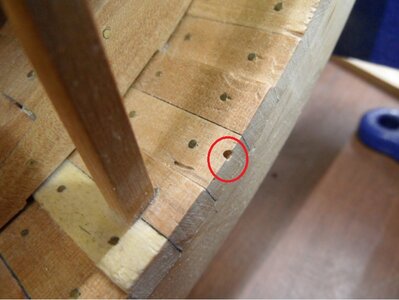- Joined
- Jun 7, 2022
- Messages
- 8
- Points
- 23

I had no intention (yet) of writing on the forum, I sent a message to Uwek regarding a question, but unfortunately even he is not familiar with it, so I will open a topic here.
How to protect wood from bugs and other that can destroy model in the future?
Problem is when you have bugs in wood BEFORE you start model and you didn't know.
How you check or prepare wood before your work?
This is from one other forum where one modeler find a hole in his model:

this is transcript:
How to protect wood from bugs and other that can destroy model in the future?
Problem is when you have bugs in wood BEFORE you start model and you didn't know.
How you check or prepare wood before your work?
This is from one other forum where one modeler find a hole in his model:

this is transcript:
***
I noticed holes in the bottom plating of the hold, which I did not make. the bark beetles are up to it ... " The only solution will be to burn the model and all the wood I have, the entire workshop and I don't know what else. And that's how my modeling ends. But seriously - I have nothing to fear, will the cattle eat the glue and die?
The model in the ends and several parts (tow trucks) are "smeared" with linseed oil. Why not apply chemistry instead?
No vermin likes chemicals.
Maybe 3V3 oil is mentioned so often here?
Give me some advice. PLEASE : cry:
If this goes on, there will be a pile of sawdust left from below by the time I reach the upper decks.
***
Hello. Inject kerosene or chemicals into the holes, preferably with a small syringe and needle. Be careful with chemicals, it's damn harmful, do it in the basement or garage. With kerosene, the treatment must be repeated every few days, up to three or four times.
***
You can also mix kerosene with turpentine in a ratio of 1: 1 by volume and with this mixture, using the aforementioned syringe, pour the workings. You can also pour turpentine on the surface of the model and cover it with foil so that it evaporates into the interior of the wood and wait a few weeks. First make sure that the foil you are going to use does not dissolve from the turpentine.
The first foil I would try would be stretch foil, because it adheres nicely and you can buy almost any amount.
Plus, you probably have it at home.
***
Thanks for the advice.
I injected kerosene into these holes several times.
Not much, but still.
The wood that I have in stock must have this in it.
Until now, during processing, none of the pieces had traces of woodworms.
Honestly - I was checking every piece in this respect.
And now, having looked at the "clip" of wood, I did not notice anything suspicious.
I must have missed something.
I will closely monitor for any new traces.
If kerosene alone does not help, I will follow advice and the model will go into quarantine in a turpentine environment.
***


